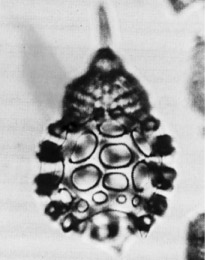 Thyrsocyrtis
(Thyrsocyrtis) bromia Ehrenberg
Thyrsocyrtis
(Thyrsocyrtis) bromia Ehrenberg Thyrsocyrtis
(Thyrsocyrtis) bromia Ehrenberg
Thyrsocyrtis
(Thyrsocyrtis) bromia EhrenbergThyrsocyrtis bromia Ehrenberg, 1873, p.260; 1875, pl.12, fig.2; Sanfilippo and Riedel, 1982, p.172, pl.1, figs.17-20 (with synonymy)
Inflated form with somewhat constricted mouth. Cephalis subspherical with moderate number of small pores, and with conical (sometimes fluted) horn several times its length, which in many specimens is roughened or thorny distally. Thorax campanulate, in some assemblages tending to be cylindrical distally and conical proximally, with thorny to tuberculate surface and rounded pores of varying size. Lumbar stricture distinct. Abdomen subcylindrical to inflated, with 12 pores on half-circumference in early specimens and 5-8 in late ones. Differentiated peristome (thicker and wider than a pore bar) about two thirds as broad as abdomen, often with three short, triangular feet (Sanfilippo and Riedel, 1982).
Based on 20 specimens. Total length excluding horn 145-215 µm, of thorax 40-70 µm, of abdomen 65-110 µm. Maximum width 105-160 µm (Sanfilippo and Riedel, 1982).
Differs from Thyrsocyrtis rhizodon in having large abdominal pores. From T. tetracantha it differs in possessing a distinct peristome, and from T. triacantha in having shorter feet or none -- in addition, both of these species have a simple, conical thorax (Sanfilippo and Riedel, 1982).
T. bromia is distinguished from its ancestor T. rhizodon by the larger pores on the abdomen, and from T. tetracantha by a distinct peristome, which is thicker and wider than a pore-bar, three feet much shorter when present, and by the porous cephalis (Sanfilippo et al., 1985).
Early forms of T. bromia have a thorax that is cylindrical below and conical above, usually thorny, abdomen annular with small circular to subcircular pores, twice as many as later specimens (12 pores on a half-circumference of the abdomen), and a narrow peristome surrounding the wide aperture. In later forms the thorax becomes campanulate with a rough and thorny, sometimes tuberculate, surface. The abdomen varies in shape from cylindrical to inflated, with 5-8 pores across its half-circumference. A peristome of varying width is always present, sometimes with three short triangular feet. The aperture is less constricted in earlier forms (Sanfilippo et al., 1985).
T. bromia is widespread in late Eocene assemblages from the tropics. Its morphotypic first appearance lies within the Podocyrtis goetheana Zone. Its morphotypic last appearance lies within the Cryptocarpium ornatum Zone.
Although only rare transitional forms have been found, it appears that T. bromia arose from T. rhizodon and left no descendants.